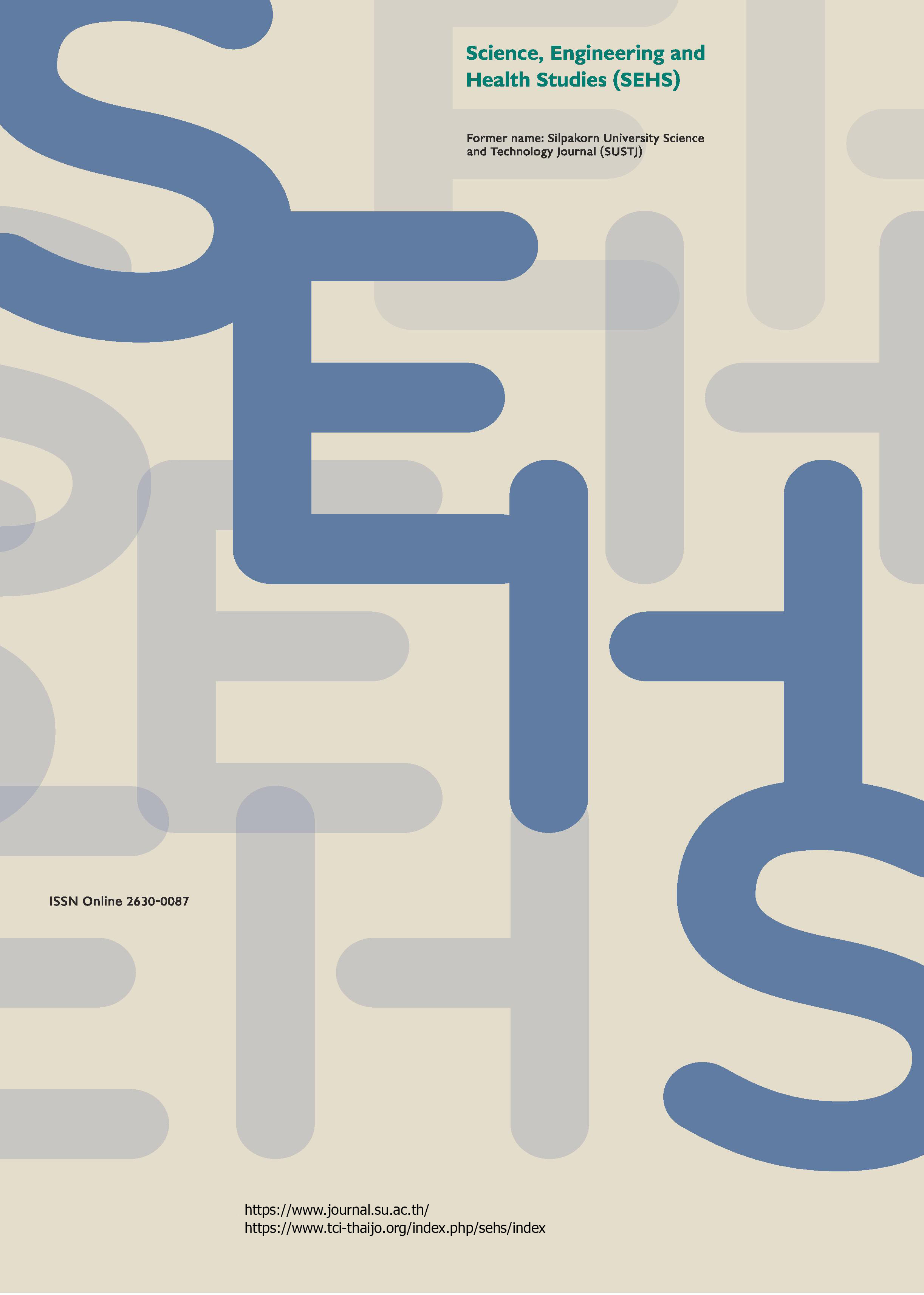Optimization of hydroxypropyl β-cyclodextrin-isophane insulin complex-loaded thiolated chitosan/sodium alginate nanoparticles using full factorial design
Main Article Content
Abstract
Isophane insulin (N) is challenging to administer orally due to its gastrointestinal instability. Research has shown that partially complexing N with hydroxypropyl β-cyclodextrin (HPβCD-N complexes) enhances its stability. Nanoparticles (NPs) are also frequently used to encapsulate drugs to protect them from degradation. This study aimed to optimize HPβCD-N complex-loaded thiolated chitosan/alginate (TCS/ALG) NPs using a full factorial design. The HPβCD-N complexes were prepared before being loaded into the NPs. Independent variables included the concentrations of TCS, ALG, and HPβCD-N complex, while the dependent variables were particle size and zeta potential. The results demonstrated that TCS and ALG concentrations had a positive and negative effect on particle size, respectively, with smaller particles being favored. The zeta potentials of the NPs increased positively and negatively in proportion to the TCS and ALG concentrations, respectively. The HPβCD-N complexes had a minimal effect on the dependent variables. The NPs made with TCS, ALG, and HPβCD-N complex concentrations of 0.075%, 0.0375%, and 5% w/w, respectively, were the most suitable for achieving small particle size and zeta potential within +30 mV and +50 mV. TEM images showed spherical particles with nanometer diameters. The encapsulated N was found to be approximately 1% w/w, confirming successful loading of N into the NPs. Thus, the optimized formulation shows potential as an NP carriers for N delivery.
Downloads
Article Details

This work is licensed under a Creative Commons Attribution-NonCommercial-NoDerivatives 4.0 International License.
References
Aggarwal, S., Tanwar, N., Singh, A., and Munde, M. (2022). Formation of protamine and Zn-insulin assembly: exploring biophysical consequences. ACS Omega, 7(45), 41044–41057.
Bucur, P., Fülöp, I., and Sipos, E. (2022). Insulin complexation with cyclodextrins—A molecular modeling approach. Molecules, 27(2), 465.
Carino, G. P., and Mathiowitz, E. (1999). Oral insulin delivery. Advanced Drug Delivery Reviews, 35(2–3), 249–257.
Chamsai, B., Opanasopit, P., and Samprasit, W. (2023). Fast disintegrating dosage forms of mucoadhesive-based nanoparticles for oral insulin delivery: Optimization to in vivo evaluation. International Journal of Pharmaceutics, 647, 123513.
Danaei, M., Dehghankhold, M., Ataei, S., Hasanzadeh Davarani, F., Javanmard, R., Dokhani, A., Khorasani, S., and Mozafari, M. R. (2018). Impact of particle size and polydispersity index on the clinical applications of lipidic nanocarrier systems. Pharmaceutics, 10(2), 57.
Deshmukh, R. K., and Naik, B. (2013). Diclofenac sodium-loaded eudragit® microspheres: Optimization using statistical experimental design. Journal of Pharmaceutical Innovation, 8, 276–287.
Kumar, A., and Dixit, C. K. (2017). Methods for characterization of nanoparticles. In Advances in Nanomedicine for the Delivery of Therapeutic Nucleic Acids (Nimesh, S., Chandra, R., and Gupta, N., Eds.), pp. 43–58. Duxford, Cambridgeshire: Woodhead Publishing.
Kumari, A., Yadav, S. K., and Yadav, S. C. (2010). Biodegradable polymeric nanoparticles based drug delivery systems. Colloids and Surfaces B: Biointerfaces, 75(1), 1–18.
Masalova, O., Kulikouskaya, V., Shutava, T., and Agabekov, V. (2013). Alginate and chitosan gel nanoparticles for efficient protein entrapment. Physics Procedia, 40, 69–75.
Motwani, S. K., Chopra, S., Talegaonkar, S., Kohli, K., Ahmad, F. J., and Khar, R. K. (2008). Chitosan-sodium alginate nanoparticles as submicroscopic reservoirs for ocular delivery: Formulation, optimisation and in vitro characterisation. European Journal of Pharmaceutics and Biopharmaceutics, 68(3), 513–525.
Patel, S., Koradia, H., and Parikh, R. (2015). Design and development of intranasal in situ gelling system of Midazolam hydrochloride using 32 full factorial design. Journal of Drug Delivery Science and Technology, 30(Part A), 154–162.
Rahbarian, M., Mortazavian, E., Dorkoosh, F. A., and Tehrani, M. R. (2018). Preparation, evaluation and optimization of nanoparticles composed of thiolated triethyl chitosan: A potential approach for buccal delivery of insulin. Journal of Drug Delivery Science and Technology, 44, 254–263.
Rahman, M. S., Hossain, K. S., Das, S., Kundu, S., Adegoke, E. O., Rahman, M. A., Hannan, M. A., Uddin, M. J., and Pang, M. G. (2021). Role of insulin in health and disease: An update. International Journal of Molecular Sciences, 22(12), 6403.
Raval, N., Maheshwari, R., Kalyane, D., Youngren-Ortiz, S. R., Chougule, M. B., Rakesh K., and Tekade, R. K. (2019). Importance of physicochemical characterization of nanoparticles in pharmaceutical product development. In Basic Fundamentals of Drug Delivery, A volume in Advances in Pharmaceutical Product Development and Research (Tekade, R. K., Ed.), pp. 369–400. Cambridge, MA: Academic Press.
Sajeesh, S., and Sharma, C. P. (2006). Cyclodextrin-insulin complex encapsulated polymethacrylic acid based nanoparticles for oral insulin delivery. International Journal of Pharmaceutics, 325(1–2), 147–154.
Samprasit, W., Kaomongkolgit, R., Sukma, M., Rojanarata, T., Ngawhirunpat, T., and Opanasopit, P. (2015). Mucoadhesive electrospun chitosan-based nanofibre mats for dental caries prevention. Carbohydrate Polymers, 117, 933–940.
Sharma, D., Maheshwari, D., Philip, G., Rana, R., Bhatia, S., Singh, M., Gabrani, R., Sharma, S. K., Ali, J., Sharma, R. K., and Dang, S. (2014). Formulation and optimization of polymeric nanoparticles for intranasal delivery of lorazepam using Box-Behnken Design: In vitro and in vivo evaluation. BioMed Research International, 2014(1), 156010.
Sonaje, K., Chen, Y. J., Chen, H. L., Wey, S. P., Juang, J. H., Nguyen, H. N., Hsu, C. W., Lin, K. J., and Sung, H. W. (2010). Enteric-coated capsules filled with freeze-dried chitosan/poly(γ -glutamic acid) nanoparticles for oral insulin delivery. Biomaterials, 31(12), 3384–3394.
Vinothini, K., and Rajan, M., (2019). Mechanism for the Nano-Based Drug Delivery System. In Characterization and Biology of Nanomaterials for Drug Delivery (Mohapatra, S. S., Ranjan, S., Dasgupta, N., Mishra, R. K., and Thomas, S., Eds.), pp. 219–263. Amsterdam: Elsevier.
Wu, L., Zhang, J., and Watanabe, W. (2011). Physical and chemical stability of drug nanoparticles. Advanced Drug Delivery Reviews, 63(6), 456–469.
Zhang, N., Li, J., Jiang, W., Ren, C., Li, J., Xin, J., and Li, K. (2010). Effective protection and controlled release of insulin by cationic β-cyclodextrin polymers from alginate/chitosan nanoparticles. International Journal of Pharmaceutics, 393(1–2), 213–219.


